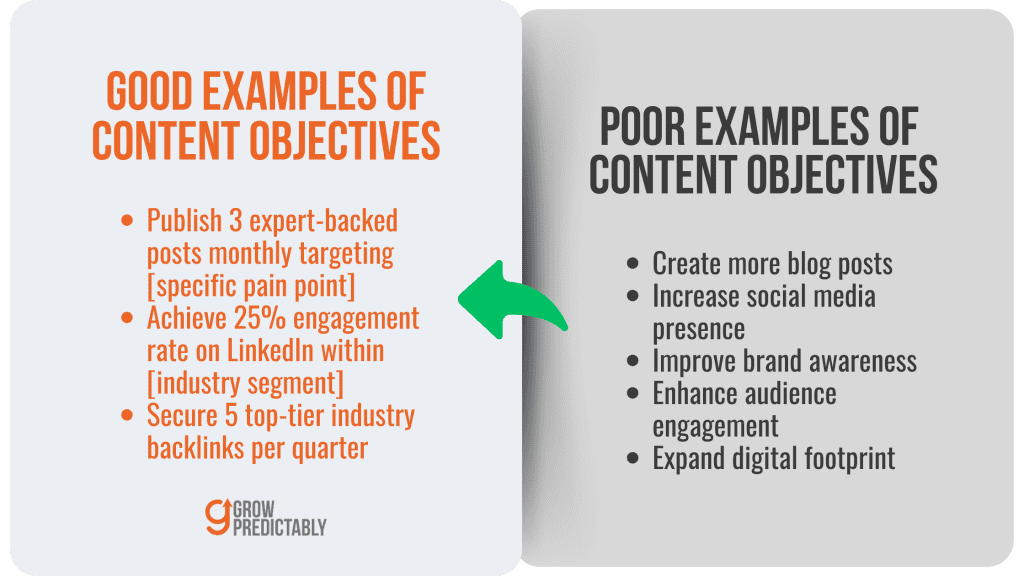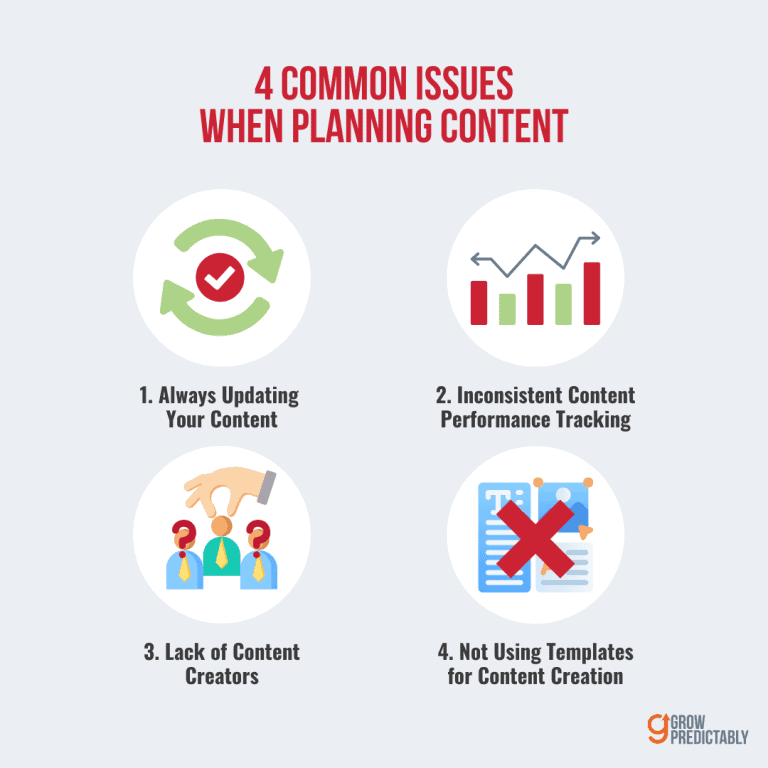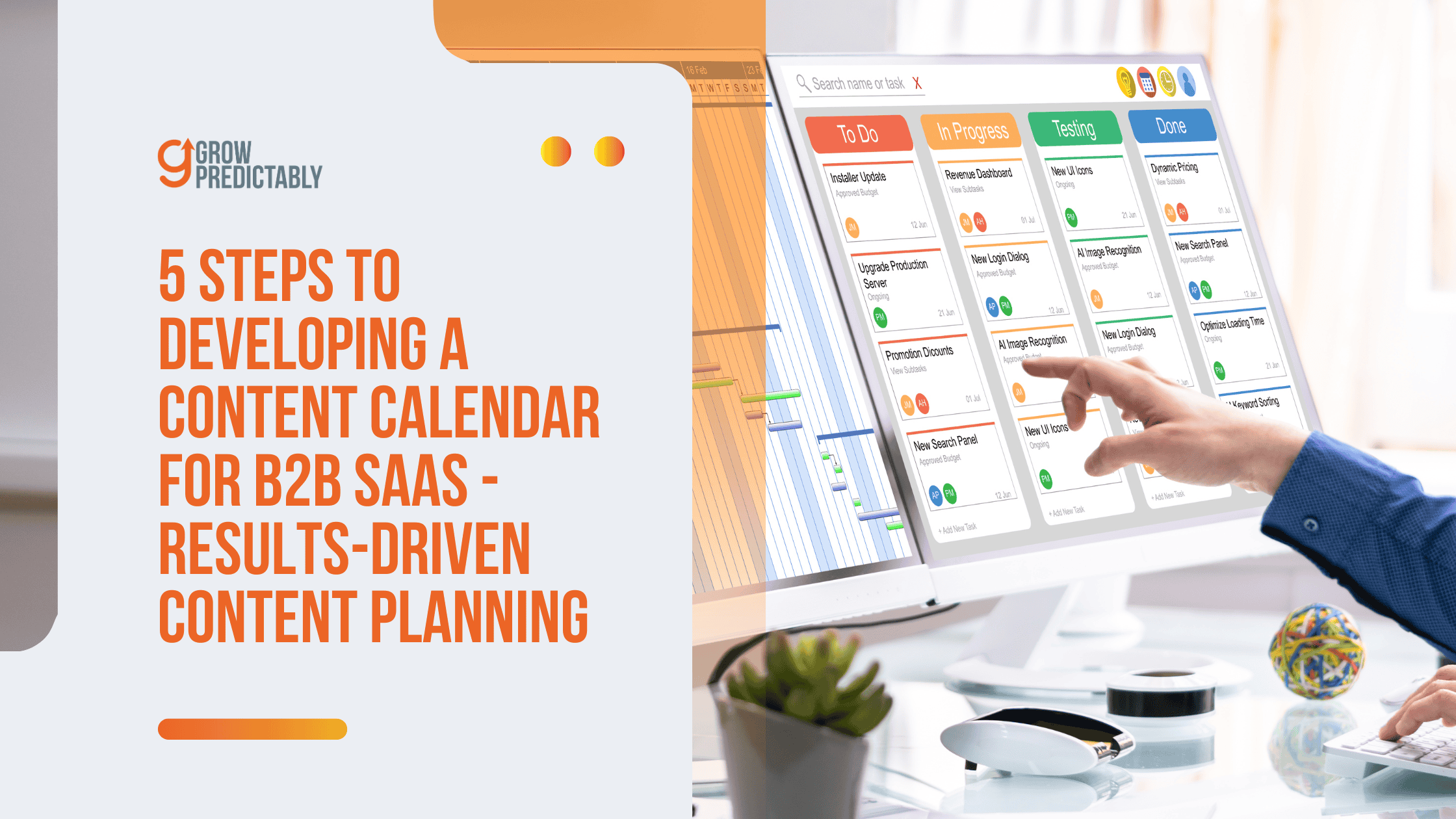5 Steps to Developing a Content Calendar for B2B SaaS – Results-Driven Content Planning
What’s the difference between B2B SaaS content that converts and content that just fills space?
Stop gambling with ad-hoc content creation—it’s dragging your conversion rates down and wasting valuable resources.
Instead, follow the lead of top-performing teams who’ve cracked the code using strategic content calendars to drive up to 67% more leads. (Source)
The framework exists—but most SaaS companies aren’t using it correctly.
Ready to transform your content planning into a results-driven machine?
Let’s break what you need to get started with when developing a content calendar for B2B SaaS.
TL;DR
Focus your calendar on business goals, buyer stages, and measurable KPIs. Build customer avatars, choose tools (Trello, Airtable, Notion) your team will use daily, diversify formats mapped to the funnel, and measure performance for each content. Iterate monthly using a content scorecard to double down on high-converting topics.
KEY TAKEAWAYS
- Set SMART objectives tied to funnel stages and assign KPIs for each content type so every piece has a clear conversion goal.
- Build detailed customer avatars, prioritize topics with an impact vs. effort matrix, and map each post to a persona and buyer stage.
- Pick one shared tool, enforce SLAs for drafts/reviews, integrate analytics (GA4, UTMs), and run a monthly scorecard to optimize the calendar.
Are Content Calendars Crucial for B2B SaaS Marketing?
A recent Content Marketing Institute study found that the most successful companies have a documented content strategy instead of just running ad-hoc campaigns. (Source)
But raw numbers only tell part of the story.
Think of your content as a strategic weapon. Without proper planning, you’re basically throwing darts in the dark.
A content calendar acts as your targeting system, helping you hit revenue goals with sniper-like precision.
Here’s the raw truth: Most B2B SaaS companies waste resources on random content that doesn’t convert.
Your engineers are building amazing features while marketing scrambles to create last-minute blog posts.
This type of disconnect will cost you money.
A well-structured calendar fixes this by:
- Matching content to your sales cycle stages
- Scheduling pieces that support product launches
- Coordinating across teams (product, sales, marketing)
- Tracking ROI of each content piece
- Planning distribution across channels
Your content calendar isn’t just a schedule – it’s a strategic blueprint that connects marketing efforts to business outcomes.
Miss this foundation, and you’ll keep producing content that fails to drive growth.
If you want to build this foundation, of course, you’ll need a guide to direct your path.
It’s a good thing that following five clear steps can launch you easily in that direction.
Here’s what you need to do in order to get started with a content calendar that will drive real results.
Step 1: Setting Objectives for Your B2B SaaS Content Calendar
Are you shooting arrows in the dark with your content strategy, or are you aiming at clear targets?
Let’s transform your content calendar from a simple scheduling tool into a strategic powerhouse.
Setting clear objectives for your B2B SaaS content calendar isn’t just about filling slots with blog posts – it’s about aligning every piece of content with specific business goals.
Here’s how to do it right.
Start by asking yourself these crucial questions:
- What’s your primary business objective?
- Lead generation
- Product adoption
- Customer retention
- Brand awareness
- Market education
For example, if you’re launching a new feature, your content calendar might focus on educational content leading up to the launch, followed by user guides and success stories afterward.
Many B2B SaaS companies set vague objectives like “create more content” or “increase engagement.”
Instead, make your objectives SMART:
- Specific: “Generate 500 qualified leads through gated whitepapers”
- Measurable: “Increase demo sign-ups by 25%”
- Achievable: “Publish two thought leadership pieces monthly”
- Relevant: “Boost product adoption rates by 15%”
- Time-bound: “Achieve these goals by Q4 2024”

PRO TIP: Layer your objectives based on your sales funnel
- Top funnel: Build awareness through educational content
- Middle funnel: Generate leads with solution-focused pieces
- Bottom funnel: Convert with product comparisons and case studies
Remember to align your content calendar with key business milestones:
- Product launches
- Industry events
- Seasonal peaks
- Competitive movements
Now that you understand how to set clear objectives, it’s time to identify exactly who you’re creating this content for.
In the next section, we’ll dive into building detailed customer avatars that will make your content irresistible to your target audience.
Step 2: Identifying Target Audiences Using the Customer Avatar Canvas
Your customers aren’t just data points – they’re real people with genuine needs and dreams.
The Customer Avatar Canvas breaks this down into actionable segments.
The Customer Avatar Canvas is a strategic tool for creating detailed customer profiles in B2B SaaS marketing. It goes beyond basic demographics to capture psychographics, specific needs, and pain points. What makes it unique is its ‘Before/After’ component that shows how customers transform through using your product or service. The canvas helps marketing teams develop targeted content, personalize campaigns, and build products that precisely match customer needs. It’s especially valuable when you need to deepen your understanding of your target market.
Let’s start with a practical example: A fitness app company found that their most successful content wasn’t about exercise routines but about overcoming self-doubt.
Start by mapping these five key areas:
- Core Demographics: Focus on relevant traits only. For a B2B software company, knowing your avatar’s job title and decision-making power matters more than their favorite TV shows.
- Pain Points That Drive Action:
- Time management struggles
- Budget constraints
- Team communication issues
- Fear of making wrong purchasing decisions
- Success Triggers:
- Clear ROI potential
- Quick implementation timeline
- Strong social proof
- Easy team adoption
- Information Sources:
- Industry-specific podcasts
- LinkedIn groups
- Professional associations
- Trusted peer recommendations
- Purchase Behavior:
- Decision-making process
- Budget authority
- Typical research timeline
- Common objections
You can also try running a “day-in-the-life” exercise.
Map out your avatar’s typical workday, focusing on moments where your solution could make a real difference.
This reveals natural content opportunities and timing for your marketing messages.
You have to remember that what customers say they want isn’t always what they need.
Dig deeper through customer interviews and support ticket analysis to uncover their true motivations.
Step 3: Choosing the Right Tools for Your B2B SaaS Content Calendar
Which content calendar tool fits your team best?
Here’s a sharp breakdown of three top options based on real usage across hundreds of B2B SaaS companies:

Trello
Trello is perfect for small teams that need a visual, drag-and-drop interface.
Pros:
- Intuitive Kanban-style interface
- Easy drag-and-drop functionality
- Free tier available
- Excellent for small to medium teams
Cons:
- Limited customization in free version
- Can become cluttered with multiple content streams
- Basic reporting capabilities
POWER TIP: Use butler automation to auto-assign due dates and team members

Airtable
Airtable is perfect for mid-size teams needing deep customization.
Pros:
- Powerful database capabilities
- Multiple view options (calendar, kanban, grid)
- Advanced filtering and sorting
- Robust automation features
Cons:
- Steeper learning curve
- Higher price point
- It can be overwhelming for simple needs
POWER TIP: Create linked tables to connect content pieces with performance metrics

Notion
Perfect for: Teams who need wiki-style documentation with their calendar
Pros:
- Highly customizable
- Combines documents and databases
- Great for content collaboration
- Flexible template system
Cons:
- May require initial setup time
- Can be too flexible for structured teams
- Requires clear organization protocols
POWER TIP: Use relations to link content briefs directly to calendar entries
Start with a 2-week trial of each tool.
Pick the one where your team logs in daily without prompting – that’s your winner.
Next up in Step 4, we’ll explore how to mix different content types in your calendar for maximum impact.
Step 4: Developing and Integrating Diverse Content Formats
Research from Think with Google shows that B2B prospects perform a dozen online searches before visiting a vendor’s website. (Source)
That’s why smart content diversity hits different touchpoints throughout the customer journey.
Your content mix should include these proven formats:
- Top-of-funnel awareness
- Short-form videos (2-3 minutes) explaining core problems
- Visual infographics breaking down industry trends
- Blog posts targeting specific pain points
- Social media carousel posts with quick tips
- Middle-funnel consideration
- Detailed case studies showing real results
- Product demonstration videos
- Expert webinars diving into solutions
- Comparison guides and spec sheets
- Bottom-funnel decision
- Customer success stories with metrics
- Technical white papers
- ROI calculators
- Implementation guides
- Security documentation
You can also map each piece of content to your customer’s journey using the Customer Value Journey framework.
For a CFO’s journey, map your content formats to match their analytical decision-making process. Start with high-level infographics showing industry trends for awareness.
Move to detailed ROI calculators and cost analysis spreadsheets during consideration. Share case studies with concrete financial metrics and implementation timelines for evaluation.
Finally, provide technical documentation and security whitepapers for validation. Each format builds on the last, guiding them naturally from initial interest to confident decision-making.
Your content calendar should maintain a healthy mix across formats.
Using Monday.com or ClickUp (from Step 3), create content buckets for each format and stage. This keeps your pipeline filled with diverse, purposeful content.
For maximum impact, repurpose strategically.
Turn that webinar into blog posts, social snippets, and an email series.
Each piece should feed into your broader content ecosystem.
Stay tuned for Step 5, where we’ll explore how to measure which formats drive the best results for your specific audience.
Step 5: Measuring and Optimizing Your Content Calendar for Results
Is your content calendar actually moving the needle?
Let’s cut through the noise and focus on metrics that matter.
Track these specific KPIs weekly:
- Page-level bounce rates (aim for under 65%)
- Time on page (8+ minutes for long-form content)
- Social sharing rates (benchmark against your top 3 posts)
- Email click-through rates per content type
- Conversion rates by topic cluster
Set up custom dashboards in Google Analytics 4 to monitor:
- Content performance by buyer journey stage
- Topic cluster effectiveness
- Format-specific engagement patterns
- Lead quality scores by content source
Quick optimization wins:
- Refresh underperforming posts (< 100 visits/month)
- A/B test headlines on top-traffic pages
- Update internal links in the top 20 posts
- Cross-promote winning formats
- Double down on topics with high conversion rates
Create a monthly content scorecard comparing:
- Top 5 performing pieces
- Bottom 5 performing pieces
- New vs returning visitor ratios
- Mobile vs desktop engagement
- Social platform breakdown
REMEMBER: Raw traffic means nothing without context.
Focus on engagement metrics that align with business goals. Adjust your calendar based on real data, not assumptions.
What Are Best Practices for Content Calendar Planning?
Which do you think is considered a best practice: tracking SEO rankings monthly or weekly?
Experts say that to keep track of your performance on rankings, reviewing SEO analytics is a must on a weekly basis.
Some go as far as tracking it every day, just like folks from SEOClarity.
Because search algorithms shift as much as 500-600 times a year, according to a WebFX resource, quick adjustments make a real difference. (Source)
Map your content calendar to target keywords, but leave 30% of slots open for trending topics and industry shifts.
1. SEO Alignment
Your content calendar isn’t just a scheduling tool – it’s your SEO powerhouse.
Track your target keywords’ performance using tools like Ahrefs or SEMrush, and adjust your content themes accordingly.
Map each piece of content to specific keyword clusters and search intent, ensuring you’re not just creating content but building search engine authority.
2. Flexible Planning Framework
Many companies struggle with rigid content calendars that can’t adapt to market changes.
Here’s the solution: implement a 70-20-10 rule:
- 70% planned cornerstone content
- 20% trending topic slots
- 10% experimental content
This framework allows you to maintain consistency while staying agile enough to jump on industry trends and breaking news.
Distribution matters as much as creation.
Build a clear process:
- Pre-write social copy when drafting content
- Brief sales teams on upcoming pieces
- Create email snippets for account managers
- Plan paid promotion for top-performing content
- Schedule LinkedIn posts during peak B2B hours (Tuesday-Thursday, 9am-2pm)
Performance tracking should focus on engagement depth.
3. Performance Tracking Integration
Remember those metrics we discussed in Step 5? Your calendar should include regular performance review checkpoints.
Schedule monthly content audits to assess:
- Top-performing pieces
- Underperforming content that needs optimization
- Content gaps based on audience feedback
- SEO performance metrics
Now that you’ve got these best practices down let’s look at some real-world examples of companies that have mastered their content calendars – and the remarkable results they’ve achieved.
As a rule of thumb, anyone involved in your business’s content marketing should never forget that B2B readers want solutions, not fluff.
Case Study: How RBC Scaled Content Across 22 Teams

In this Contently case study, we’ll look at how the Royal Bank of Canada (RBC), one of the world’s largest financial institutions with over 85,000 employees and 17 million clients, recognized the need for a cohesive content strategy to compete for consumer attention against major media organizations effectively.
To address this, RBC partnered with Contently to implement a scalable content marketing approach across its diverse divisions.
Problem
- Consistency Across Divisions: RBC aimed to ensure a steady flow of content that resonated with its broad audience, necessitating uniformity across various departments.
- Efficient Content Review: The existing content approval process was time-consuming, often delaying publication by weeks.
Solutions
- Data-Driven Content Audit: Collaborating with Contently, RBC conducted a comprehensive content audit to identify opportunities for engaging consumers at the top of the marketing funnel, focusing on education and entertainment before product promotion.
- Decentralized Content Creation: Each department, starting with personal and commercial banking and expanding to insurance, wealth management, and RBCxMusic, was empowered to define its target audience and produce tailored content. This decentralized model allowed departments to align their specific goals with overarching corporate objectives.
- Streamlined Legal Review Process: By designating a single legal team member to review all content and integrating this role into Contently’s custom workflow, RBC significantly reduced approval times. The development of a reference document outlining key considerations further expedited the process.
Results
- Increased Engagement: RBC achieved an 81% engagement rate, with a content finish rate 15% higher than the industry average.
- Expanded Content Production: The initiative scaled to 22 divisions, actively creating content fostering a unified brand voice across the organization.
- Accelerated Publication Timelines: The streamlined review process enabled some teams to publish content within a day or two, a substantial improvement from the previous weeks-long timeline.
This case study underscores the critical role of strategic content planning and the implementation of efficient workflows in enhancing organizational coherence and audience engagement.
For B2B businesses to emulate these results, here are actionable takes that focus on content strategizing:
- Leverage Content Calendars for Consistency: Implementing a content calendar ensures a steady, consistent flow of content across all departments, maintaining a unified brand voice and message.
- Prioritize a Scalable Content Strategy: Adopt a decentralized content creation model that empowers individual teams to align their content goals with broader organizational objectives while catering to their unique audiences.
- Streamline Approval Processes: Designate a dedicated reviewer or team to handle legal and compliance checks. Integrating review steps into a structured workflow, as RBC did, can significantly reduce bottlenecks in publication timelines.
- Use Data to Drive Content Decisions: Conduct audits to identify content gaps and areas where your audience is seeking value, particularly in educational or entertainment content, that builds trust before introducing products or services.
- Expand Across Divisions Strategically: Start with key areas that impact revenue or engagement and expand gradually to other divisions, ensuring seamless adoption and integration of the content calendar and associated processes.
By following these principles, B2B organizations can maximize their content strategy’s efficiency and effectiveness, driving both audience engagement and business growth.
What Are Common Challenges in Content Planning?

Every content team has been there – missing deadlines, rushing content, and constantly playing catch-up.
These aren’t just minor inconveniences.
They’re symptoms of a deeper problem in your content planning system.
Let’s look at why these challenges happen and how to solve them:
1. The Reactive Content Trap
When you’re always reacting to market changes or competitor moves, you’re never ahead.
Your content quality suffers, and your team burns out.
Build flexibility into your calendar by reserving 20% of your slots for unexpected content needs. Schedule quarterly “flex weeks” specifically for addressing market changes or emerging opportunities. This gives you breathing room without derailing your regular content schedule.
2. Inconsistent Performance Tracking
Many teams wait until month-end to check content performance.
By then, it’s too late to adjust course or capitalize on what’s working.
Implement weekly performance tracking to spot trends early. Create a simple system to flag underperforming content for quick updates. Run brief daily content standups to identify and address issues before they become problems.
3. Resource Bottlenecks
When deadlines pile up, having limited resources can bring your content production to a halt.
Build relationships with reliable freelancers before urgent needs arise. Cross-train your team members on different content types so they can fill in when needed. Consider creating content pods – small teams with overlapping skills who can support each other during busy periods.
4. Quality Compromises Under Pressure
When rushed, teams often sacrifice quality for speed, damaging your brand’s credibility.
Develop pre-approved templates for common content types. Create a streamlined quality checklist for rushed pieces. Build a content emergency kit containing templates, guidelines, and resources your team can quickly access when time is tight.
Remember to make your content calendar work for you, not against you.
The most effective content strategies aren’t rigid – they’re resilient.
While perfect execution is great, having the flexibility to adapt while maintaining quality is what truly sets successful content teams apart.
Focus on building systems that can handle the unexpected while keeping your content quality high and your team energized.
⮞ How to organize a B2B SaaS content calendar for lead generation?
Start by treating the calendar as your lead-generation playbook. Focus on audience, funnel stage, and measurable conversion paths. Then build processes and ownership around that.
• Set clear goals and KPIs. Define target lead types, MQL criteria, and conversion metrics you’ll track (signups, demo requests, gated downloads).
• Map content to the buyer’s journey. Label each asset as TOFU, MOFU, or BOFU and specify the expected next action.
• Create content pillars and topic clusters. Align blog, white papers, webinars, and case studies to product themes and high-value keywords.
• Define cadence and format mix. Decide weekly/monthly publishing frequency and a balanced mix of formats (posts, guides, videos, emails).
• Assign owners and SLAs. Give each item an author, editor, designer, and publish date. Add deadlines for draft, review, and final approval.
• Add distribution & nurture steps. Note which channels (email, paid, social, partners) and which automated nurture sequence follows each asset.
• Track and iterate. Use UTMs, CRM tagging, and content-level analytics to attribute leads and double down on high-performing topics.
⮞ Where to find downloadable content calendar templates for SaaS marketing?
There are many reliable places to grab ready-made calendars and then customize them for SaaS needs. HubSpot offers comprehensive marketing templates that include fields for buyer stage and conversion goals.
Google Sheets and Microsoft Excel templates are common and useful because they’re easy to customize and share. Airtable and Notion communities publish flexible templates that add database power and views (calendar, kanban, grid).
Trello and Asana template boards work well if you prefer card-based workflows. Template marketplaces like Template.net or community repositories on Product Hunt and GitHub sometimes include specialized editorial planners.
Also check CMS vendors, marketing blogs, and SaaS agencies—they often publish free downloadable calendars tuned for B2B audiences. When choosing a template, ensure it has columns for title, persona, funnel stage, owner, publish date, CTA, distribution channel, assets, status, and performance metrics.
Download one close to your workflow and then adapt fields, integrations (CSV import, Zapier), and naming conventions so it becomes your single source of truth.
⮞ How to build a content calendar for B2B SaaS blogs?
Start by auditing what you already have and then prioritize content that drives pipeline and authority.
Use this step-by-step approach:
• Audit and score existing posts. Identify gaps, high-traffic pages, and low-performing but high-intent pages to refresh.
• Define goals and personas. Tie each blog topic to a persona and a measurable goal (trial signups, demo requests, email opt-ins).
• Do keyword cluster research. Build pillar pages and supporting cluster posts to capture organic visibility and internal linking benefits.
• Ideate and prioritize topics. Use an impact vs. effort matrix to pick topics that balance quick wins and strategic investments.
• Create a reusable editorial workflow. Standardize briefs, SEO checks, author, editor, designer, and publish steps with deadlines.
• Schedule cadence and formats. Decide publish frequency and mix long-form, how-to, and case-based posts; map them on a calendar.
• Plan CTAs and gating. Assign a clear CTA for each post and indicate which pieces are gated for lead capture.
• Define distribution and repurposing. Note where each post will be promoted and how it can be reused (snippets, slide decks, emails).
• Measure and optimize. Track traffic, engagement, and conversions per post, and reprioritize topics based on performance.
⮞ What are the best practices for managing a B2B SaaS content calendar remotely?
Keep the process simple and the responsibilities crystal clear. Use a single, shared source of truth like a cloud-based calendar or centralized content database so everyone always sees the same plan.
Assign explicit roles for each content piece: author, editor, designer, and owner who signs off. Create standard templates and brief forms to remove ambiguity and speed up handoffs.
Set SLAs for drafts, reviews, and publishing so timelines are predictable despite different time zones. Use async communication—comments in the calendar, tracked edits, and recorded walk-throughs—to reduce meeting load.
Schedule short recurring check-ins for priorities and blockers, not status dumps. Integrate your calendar with CMS, CRM, and analytics so publishing triggers distribution and allows accurate lead attribution.
Keep version control and archive old content briefs. Ensure access controls and permissions are defined.
Finally, encourage continuous feedback loops: run monthly retrospectives to refine cadence, formats, and templates based on performance and team capacity.
Key Takeaway
Building a B2B SaaS content calendar doesn’t need to be complicated.
After reading this guide, you’ve got the essential tools to create content that hits your business targets and speaks to your audience.
Let’s put this knowledge into practice. Start by mapping out your next quarter’s content using our proven framework.
REMEMBER: Strong objectives, clear audience segments, and consistent delivery are your building blocks.
The steps we’ve covered—from audience research to performance tracking—will help you build a content machine that delivers real results.
No more random posts or missed opportunities.
Ready to level up your content game?
The difference between good and great content marketing often comes down to organization and strategy.
You’ve got the blueprint—now it’s time to build.








